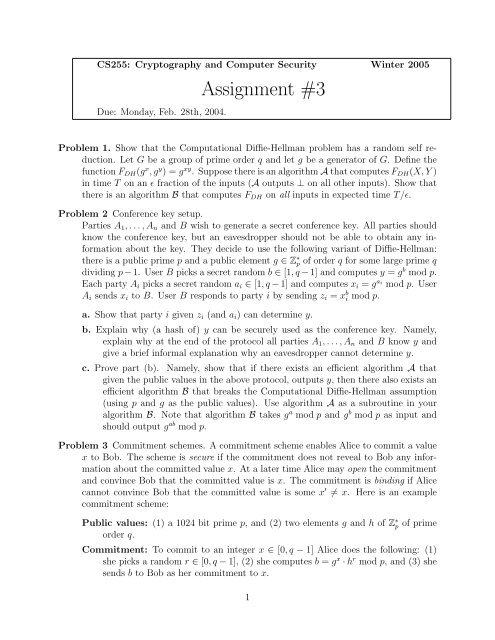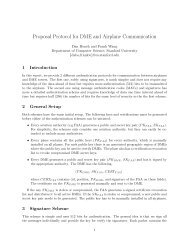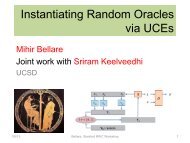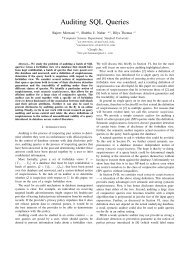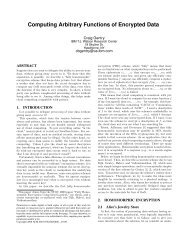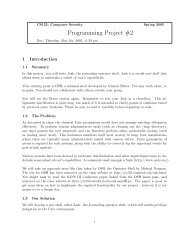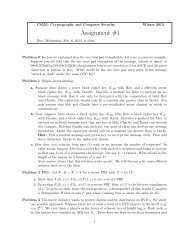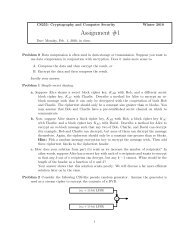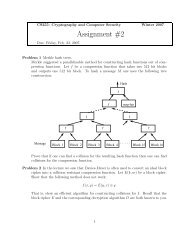Assignment #3 - Applied Crypto Group at Stanford University
Assignment #3 - Applied Crypto Group at Stanford University
Assignment #3 - Applied Crypto Group at Stanford University
You also want an ePaper? Increase the reach of your titles
YUMPU automatically turns print PDFs into web optimized ePapers that Google loves.
CS255: <strong>Crypto</strong>graphy and Computer Security Winter 2005<br />
Due: Monday, Feb. 28th, 2004.<br />
<strong>Assignment</strong> <strong>#3</strong><br />
Problem 1. Show th<strong>at</strong> the Comput<strong>at</strong>ional Diffie-Hellman problem has a random self reduction.<br />
Let G be a group of prime order q and let g be a gener<strong>at</strong>or of G. Define the<br />
function FDH(g x , g y ) = g xy . Suppose there is an algorithm A th<strong>at</strong> computes FDH(X, Y )<br />
in time T on an ɛ fraction of the inputs (A outputs ⊥ on all other inputs). Show th<strong>at</strong><br />
there is an algorithm B th<strong>at</strong> computes FDH on all inputs in expected time T/ɛ.<br />
Problem 2 Conference key setup.<br />
Parties A1, . . . , An and B wish to gener<strong>at</strong>e a secret conference key. All parties should<br />
know the conference key, but an eavesdropper should not be able to obtain any inform<strong>at</strong>ion<br />
about the key. They decide to use the following variant of Diffie-Hellman:<br />
there is a public prime p and a public element g ∈ Z ∗ p of order q for some large prime q<br />
dividing p − 1. User B picks a secret random b ∈ [1, q − 1] and computes y = g b mod p.<br />
Each party Ai picks a secret random ai ∈ [1, q − 1] and computes xi = g ai mod p. User<br />
Ai sends xi to B. User B responds to party i by sending zi = x b i mod p.<br />
a. Show th<strong>at</strong> party i given zi (and ai) can determine y.<br />
b. Explain why (a hash of) y can be securely used as the conference key. Namely,<br />
explain why <strong>at</strong> the end of the protocol all parties A1, . . . , An and B know y and<br />
give a brief informal explan<strong>at</strong>ion why an eavesdropper cannot determine y.<br />
c. Prove part (b). Namely, show th<strong>at</strong> if there exists an efficient algorithm A th<strong>at</strong><br />
given the public values in the above protocol, outputs y, then there also exists an<br />
efficient algorithm B th<strong>at</strong> breaks the Comput<strong>at</strong>ional Diffie-Hellman assumption<br />
(using p and g as the public values). Use algorithm A as a subroutine in your<br />
algorithm B. Note th<strong>at</strong> algorithm B takes g a mod p and g b mod p as input and<br />
should output g ab mod p.<br />
Problem 3 Commitment schemes. A commitment scheme enables Alice to commit a value<br />
x to Bob. The scheme is secure if the commitment does not reveal to Bob any inform<strong>at</strong>ion<br />
about the committed value x. At a l<strong>at</strong>er time Alice may open the commitment<br />
and convince Bob th<strong>at</strong> the committed value is x. The commitment is binding if Alice<br />
cannot convince Bob th<strong>at</strong> the committed value is some x ′ = x. Here is an example<br />
commitment scheme:<br />
Public values: (1) a 1024 bit prime p, and (2) two elements g and h of Z ∗ p of prime<br />
order q.<br />
Commitment: To commit to an integer x ∈ [0, q − 1] Alice does the following: (1)<br />
she picks a random r ∈ [0, q − 1], (2) she computes b = g x · h r mod p, and (3) she<br />
sends b to Bob as her commitment to x.<br />
1
Open: To open the commitment Alice sends (x, r) to Bob. Bob verifies th<strong>at</strong><br />
b = g x · h r mod p.<br />
Show th<strong>at</strong> this scheme is secure and binding.<br />
a. To prove security show th<strong>at</strong> b does not reveal any inform<strong>at</strong>ion to Bob about x. In<br />
other words, show th<strong>at</strong> given b, the committed value can be any integer x ′ in<br />
[0, q − 1].<br />
Hint: show th<strong>at</strong> for any x ′ there exists a unique r ′ ∈ [0, q − 1] so th<strong>at</strong> b = g x′<br />
h r′<br />
.<br />
b. To prove the binding property show th<strong>at</strong> if Alice can open the commitment as<br />
(x ′ , r ′ ) where x = x ′ then Alice can compute the discrete log of h base g. In other<br />
words, show th<strong>at</strong> if Alice can find an (x ′ , r ′ ) such th<strong>at</strong> b = gx′ hr′ mod p then she<br />
can find the discrete log of h base g. Recall th<strong>at</strong> Alice also knows the (x, r) used<br />
to cre<strong>at</strong>e b.<br />
Problem 4. (incremental hashing) Let p be a prime and let g ∈ Z ∗ p be an element of prime<br />
order q. We let G denote the group gener<strong>at</strong>ed by g and we let I denote the set of integers<br />
{1, . . . , q}. Fix n values g1, . . . , gn ∈ G and define the hash function H : I n → G by<br />
H(x1, . . . , xn) = g x1<br />
1 g x2<br />
2 · · · g xn<br />
n<br />
a. Show th<strong>at</strong> H is collision resistant assuming discrete-log in G is intractable. Th<strong>at</strong> is,<br />
show th<strong>at</strong> an <strong>at</strong>tacker capable of finding a collision for H for a random g1, . . . , gn ∈<br />
G can be used to compute discrete-log in G.<br />
Hint: given a pair g, h ∈ G your goal is to find an α ∈ Z such th<strong>at</strong> g α = h. Choose<br />
g1, . . . , gn ∈ G so th<strong>at</strong> a collision on the resulting H will reveal α.<br />
b. Let M be a message in I n . Suppose user Alice already computed the hash of M,<br />
namely H(m). Now, Alice changes only one coordin<strong>at</strong>e of M to obtain a new<br />
message M ′ . Show th<strong>at</strong> Alice can quickly compute H(M ′ ) from H(M) in time<br />
th<strong>at</strong> is independent of the length of M.<br />
You have just shown th<strong>at</strong> after making a small change to a message there is no<br />
need to rehash the entire message. Collision resistant hash functions of this type<br />
are said to support incremental hashing.<br />
Problem 5 Let’s explore why in the RSA public key system each person has to be assigned<br />
a different modulus N = pq. Suppose we try to use the same modulus N = pq for<br />
everyone. Each person is assigned a public exponent ei and a priv<strong>at</strong>e exponent di such<br />
th<strong>at</strong> ei · di = 1 mod ϕ(N). At first this appears to work fine: to encrypt a message<br />
to Bob, Alice computes C = M ebob and sends C to Bob. An eavesdropper Eve, not<br />
knowing dbob appears to be unable to decrypt C. Let’s show th<strong>at</strong> using eeve and deve<br />
Eve can very easily decrypt C.<br />
a. Show th<strong>at</strong> given eeve and deve Eve can obtain a multiple of ϕ(N).<br />
b. Show th<strong>at</strong> given an integer K which is a multiple of ϕ(N) Eve can factor the<br />
modulus N. Deduce th<strong>at</strong> Eve can decrypt any RSA ciphertext encrypted using<br />
the modulus N intended for Alice or Bob.<br />
2
Hint: Consider the sequence g K , g K/2 , g K/4 , . . . g K/τ(N) mod N where g is random<br />
in ZN and τ(N) is the largest power of 2 dividing K. Use the the left most element<br />
in this sequence which is not equal to 1 mod N.<br />
Problem 6 Recall th<strong>at</strong> a simple RSA sign<strong>at</strong>ure S = H(M) d mod N is computed by first<br />
computing S1 = H(M) d mod p and S2 = H(M) d mod q. The sign<strong>at</strong>ure S is then found<br />
by combining S1 and S2 using the Chinese Remainder Theorem (CRT). Now, suppose<br />
a Certific<strong>at</strong>e Authority (CA) is about to sign a certain certific<strong>at</strong>e C. While the CA<br />
is computing S1 = H(C) d mod p, a glitch on the CA’s machine causes it to produce<br />
the wrong value ˜ S1 which is not equal to S1. The CA computes S2 = H(C) d mod q<br />
correctly. Clearly the resulting sign<strong>at</strong>ure ˜ S is invalid. The CA then proceeds to publish<br />
the newly gener<strong>at</strong>ed certific<strong>at</strong>e with the invalid sign<strong>at</strong>ure ˜ S.<br />
a. Show th<strong>at</strong> any person who obtains the certific<strong>at</strong>e C along with the invalid sign<strong>at</strong>ure<br />
˜S is able to factor the CA’s modulus.<br />
Hint: Use the fact th<strong>at</strong> ˜ S e = H(C) mod q. Here e is the public verific<strong>at</strong>ion<br />
exponent.<br />
b. Suggest some method by which the CA can defend itself against this danger.<br />
Extra credit: In the lecture we defined the Hash-Diffie-Hellman problem (HDH) as follows:<br />
let G be a group of prime order q and let H : G → {0, 1} n be a hash function. An<br />
algorithm A ɛ-solves the HDH problem for (G, H) if:<br />
<br />
Pr[A(g, g a , g b , H(g ab )) = “yes ′′ ] − Pr[A(g, g a , g b , H(g c )) = “yes ′′ ] ≥ ɛ<br />
where g = 1 is uniform in G and a, b, c are uniform in Z ∗ q. In other words, A is able to<br />
distinguish between a distribution of Hash-Diffie-Hellman tuples and a distribution of<br />
random tuples.<br />
We also said th<strong>at</strong> an algorithm B ɛ-breaks the semantic security of a public-key<br />
encryption scheme E if B wins the following game with probability <strong>at</strong> least 1 + ɛ:<br />
2<br />
(1) B is given a public-key gener<strong>at</strong>ed by the key gener<strong>at</strong>ion algorithm of E,<br />
(2) B outputs two messages M0, M1,<br />
(3) B is given the public key encryption of Mb under the public key from step (1) where<br />
b is random in {0, 1},<br />
(4) B returns a b ′ ∈ {0, 1} and wins the game if b = b ′ .<br />
Consider the ElGamal encryption scheme where the encryption of a message M ∈<br />
{0, 1} n is C = [g r , M⊕H(y r )] where g, y ∈ G is the public key and r is random in Zq.<br />
Show th<strong>at</strong> this ElGamal encryption scheme is semantically secure assuming HDH for<br />
(G, H) is hard. In other words, show th<strong>at</strong> if an algorithm B ɛ-breaks semantic security<br />
of ElGamal for (G, H) then there is an algorithm A with approxim<strong>at</strong>ely the same<br />
running time as B th<strong>at</strong> ɛ-breaks HDH for (G, H). Your goal is to design algorithm A<br />
for HDH in G th<strong>at</strong> uses B as a subroutine.<br />
3


